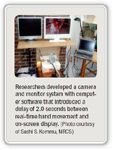Article
Training method shortens laparoscopic learning curve
The expanding use of laparoscopic techniques in urologic surgery has placed a greater demand on training programs to develop better methods to provide laparoscopic skill training. Researchers from the United Kingdom have examined how changing the temporal relationship between hand movement and perception of that movement on the monitor affected the rate of acquisition of laparoscopic skills.
Cancun, Mexico-The expanding use of laparoscopic techniques in urologic surgery has placed a greater demand on training programs to develop better methods to provide laparoscopic skill training. Researchers from the United Kingdom have examined how changing the temporal relationship between hand movement and perception of that movement on the monitor affected the rate of acquisition of laparoscopic skills. Their data, presented at the World Congress of Endourology here, showed that the introduction of a brief delay between real-time hand movement and on-screen display led to a nearly twofold decrease in the learning curve for complex laparoscopic procedures.
The group developed a camera and monitor system with computer software that introduced a delay or "time lag" of 2.0 seconds between real-time hand movement and on-screen display.

The trainees who practiced in the time-lag mode were 1.7 times faster at mastering laparoscopic vesicourethral anastomosis in this box model than were trainees who practiced in the conventional mode. Once the target skill level was reached, there was no difference among trainees in time to complete the anastomosis, with an average time of approximately 32 minutes.
Less anxiety
The researchers concluded that use of a camera-monitor system in the time-lag mode may increase the rate of learning laparoscopic skills and shorten the learning curve. As reported previously by Dr. Kommu and his colleagues, the mechanism of action of time lag may be to lessen intention anxiety (J Endourol 2006; 20: 663-8).
"Core dexterity skills in laparoscopic surgery require steady, ergonomic, purposeful movements," he said. "Introduction of the time lag forces the trainee, at least partly, to observe this rule. Once the task is mastered using time lag, the trainee can switch to real-time mode, as is done in the live human case, with very encouraging results."
Dr. Kommu's time-lag project is one of a series of projects initiated by him through the STILUS Research Group that investigate new methods to promote the acquisition of laparoscopic skills.
"Current challenges in minimally invasive urologic skill acquisition force us to look for novel ways of not only ensuring an optimal target level of skill, but also improving the rate at which a given skill is achieved," he said.
Further studies are needed in this regard to improve the quality of training in laparoscopy and other minimally invasive surgical techniques.
"These findings could be used to develop training modules to supplement current training in laparoscopic urological programs," Dr. Kommu explained. "When that trainee progresses to the live human case, he may be able to perform at a high standard. This could benefit the trainers and trainees and have a positive impact on the patient."
Dr. Kommu discloses that neither he nor his co-authors or STILUS affiliates have any financial or other incentives toward the studies undertaken by the time-lag projects discussed in this article.















